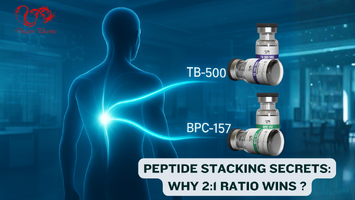Anabolix8
Board Rep
- Joined
- Dec 25, 2024
- Messages
- 345
- Reaction score
- 116
- Points
- 51
Peptide Stacking Secrets: Why 2:1 Ratio Wins
Peptides have become the quiet revolution in recovery, performance, and longevity circles. From athletes dealing with chronic injuries to those seeking faster muscle repair or connective tissue recovery, the right peptide combination can dramatically change results.
But one question consistently surfaces — what’s the optimal ratio when stacking peptides like BPC-157 and TB-500?
Surprisingly, research and real-world data both point to a 2:1 ratio as the most effective balance for maximum synergy.

Peptides have become the quiet revolution in recovery, performance, and longevity circles. From athletes dealing with chronic injuries to those seeking faster muscle repair or connective tissue recovery, the right peptide combination can dramatically change results.
But one question consistently surfaces — what’s the optimal ratio when stacking peptides like BPC-157 and TB-500?
Surprisingly, research and real-world data both point to a 2:1 ratio as the most effective balance for maximum synergy.

Understanding the Peptide Synergy
Before diving into ratios, it’s important to understand how these two compounds complement each other.
• TB-500 (Thymosin Beta-4):
This peptide promotes cell migration, angiogenesis (formation of new blood vessels), and tissue remodeling. Essentially, TB-500 acts as the “construction crew” that rebuilds tissue and enhances structural repair at a cellular level.
• BPC-157 (Body Protection Compound):
This one’s more of the stabilizer and protector. It supports anti-inflammatory pathways, accelerates collagen synthesis, and helps re-establish the nerve-to-muscle connection. BPC-157 is especially effective in protecting tissues under stress and speeding up healing in joints, tendons, and ligaments.
When combined, TB-500 drives regeneration, while BPC-157 ensures that environment remains stable and inflammation-free. The 2:1 ratio ensures both peptides perform at their peak efficiency.
Why the 2:1 Ratio Works
Studies and anecdotal reports show that using twice the dose of TB-500 compared to BPC-157 provides optimal healing acceleration without diminishing returns. Here’s why:
Mechanistic Balance:
TB-500’s action in promoting actin upregulation requires a stable inflammatory balance to prevent overregeneration. BPC-157 helps moderate that inflammation, so a slightly higher TB-500 load allows both processes to proceed efficiently.
Rate of Tissue Turnover:
Muscle fibers and connective tissues regenerate at different speeds. TB-500 stimulates faster cellular migration, while BPC-157 supports vascular stability. The 2:1 ratio aligns these timelines for smoother recovery phases.
Recovery Amplification:
Athletes using a 2:1 stack (for example, 10mg TB-500 + 5mg BPC-157 per week) consistently report faster recovery from tendon inflammation, muscle tears, and overuse injuries compared to equal dosing.
Reduced Diminishing Returns:
Overloading BPC-157 doesn’t necessarily enhance recovery beyond a certain point — its effect plateaus. Maintaining it at half the TB-500 dose keeps the synergy efficient and cost-effective.
Practical Application Guide
For research or theoretical application, here’s a common framework based on field use and literature review:
Week 1–4:
TB-500: 10mg per week
BPC-157: 5mg per week
Administration Frequency:
Split doses across 2–3 injections weekly (e.g., TB-500 M/W/F, BPC-157 M/Th).
Localized injections near affected areas can enhance site-specific recovery.
Cycle Duration:
4–6 weeks is typically sufficient for noticeable structural repair and inflammation control.
Maintenance Phase:
Lower weekly doses (e.g., 4mg TB-500 + 2mg BPC-157) can be continued if consistent stress or training intensity is high.
Scientific Insight
Laboratory data and animal studies demonstrate both peptides influence angiogenesis, fibroblast activity, and nitric oxide modulation. When used in tandem:
TB-500 boosts cellular communication via actin-binding proteins.
BPC-157 upregulates VEGF (Vascular Endothelial Growth Factor) and accelerates tendon-to-bone integration.
Together, this creates a dynamic healing environment — one builds, the other stabilizes.
Conclusion
Peptide synergy isn’t just about stacking — it’s about proportion. The 2:1 ratio of TB-500 to BPC-157 ensures regenerative efficiency, inflammation control, and optimal tissue remodeling. Whether for recovery, prevention, or high-performance maintenance, this balance stands out as the sweet spot discovered through both science and experience.
For those exploring advanced recovery or injury support stacks, verified options are available through trusted research sources like Dragonpharmastore, where peptide quality and consistency are lab-tested for precision and purity.



